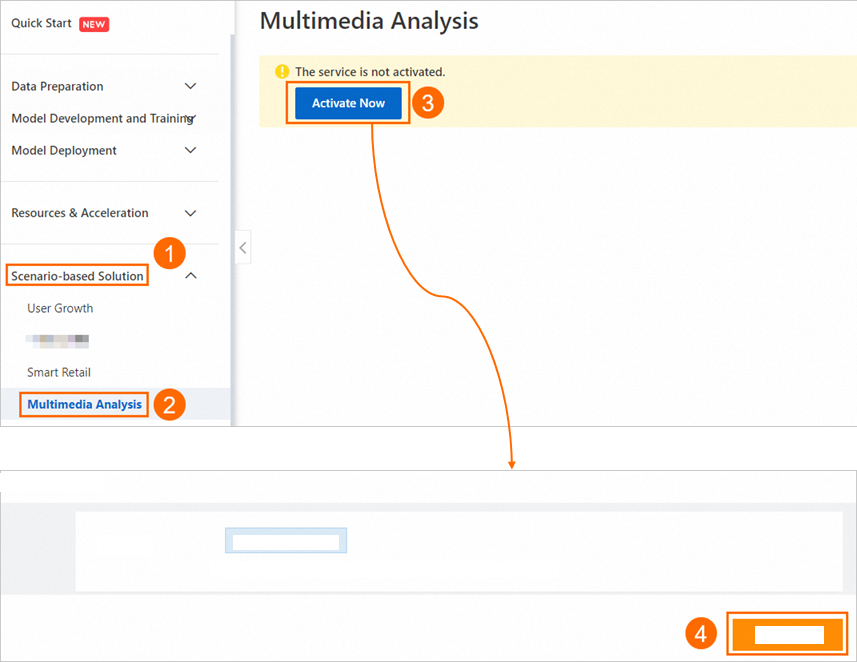Platform for AI (PAI) provides out-of-the-box multimedia analysis services that are powered by advanced algorithms. These services include Basic Model Service and Advanced Model Service. This topic describes the billing of multimedia analysis and how to use multimedia analysis.
Background information
Multimedia analysis provides the following algorithm-powered services:
Basic Model Service: model services for images, including tagging, quality evaluation, facial attribute analysis (such as appearance, face shape, hairstyle, and hair color), age analysis, figure modification (such as slimming or enlarging), and watermark removal.
Advanced Model Service: model services for videos, including tagging, quality evaluation, multi-modal content classification and tagging (used for posts that contain texts, images, and videos), and AI-generated image tagging (used to improve the performance of text-to-image models).
Billing
Multimedia analysis supports the pay-as-you-go and subscription billing methods. For more information, see Billing of multimedia analysis.
Work with multimedia analysis
Enable multimedia analysis and purchase a resource plan
To enable multimedia analysis in the Scenario-based Solution section of the PAI console, perform the following steps:
Log on to the PAI console.
Follow the instructions in the following figure to enable multimedia analysis.
By default, the pay-as-you-go billing method is used. Fees are calculated based on the number of service calls.

You can purchase resource plans to use multimedia analysis services at a more favorable price. To purchase a resource plan, perform the following steps:
On the Basic Model Service tab of the Multimedia Analytics page, click Purchase Resource Plan.
On the Subscription Model Service page, configure the Quantity, Scenarios, and API Calls parameters, and then click Buy Now.
To use multimedia analysis services, set the Scenarios parameter to Multimedia Analysis-Basic Model Service or Multimedia Analysis-Advanced Model Service. Configure the other parameters based on your business requirements.
Usage notes on multimedia analysis SDK for Python
After you enable multimedia analysis, you can use the multimedia analysis SDK for Python to call the model services. For more information, see Usage notes on multimedia analysis SDK for Python.
Usage notes on multimedia analysis SDK for Java
After you enable multimedia analysis, you can use the multimedia analysis SDK for Java to call the model services. For more information, see Java SDK on GitHub. The SDK for Java has the same parameters as the SDK for Python. For more information about the parameters, see Usage notes on multimedia analysis SDK for Python.
Features of multimedia analysis
Scenario | Service name | Calls consumed per service | Description | Sample value |
Basic Model Service | Image quality evaluation | 1 | Returns a score of the image quality. The score is a floating-point number from 0 to 100. |
|
Facial attribute analysis | 1 |
|
| |
Age analysis | 1 |
| Age groups: | |
Image tagging | 1 | Adds multiple tags to an image. This service can return the Top K tags that have the highest probabilities and their respective probabilities, or return high-dimensional features of the image. | Examples of most-used tags: female, selfie, male, lifestyle, screenshot, food, vehicle, delicacy, game, cartoon, animal, and Korean-style outfit. | |
Figure modification | 1 | Modifies the figure in the image. You can upload a portrait image and modify the figure to be larger or slimmer by adjusting the degree parameter. For example, you can set | The modified image is returned as a Base64-encoded string. | |
Watermark removal | 1 | Removes the watermarks in the image. | The image without watermarks is returned as a Base64-encoded string. | |
AI-generated image tagging | 1 | Adds tags to images that are generated by text-to-image models, such as Stable Diffusion, to improve the model performance. |
| |
Custom model service | N. The value of N varies based on the complexity of the custom model service. | Provides customized model services for images and videos. | Determined by the actual model type. | |
Advanced Model Service | Multi-modal content classification and tagging | 1 | Adds tags to multi-modal content (such as social media posts). You can categorize and add tags to content that consists of texts and images or texts and videos. The model service also returns the embedding results of high-dimensional features. |
|
Video quality evaluation | 1 | Returns a score of the video quality. The score is a floating-point number from 0 to 100. |
| |
Video classification and tagging | 1 | Returns the category of the video, the top K tags that have the highest probabilities and their respective probabilities, and the high-dimensional features of the video. |
|
Technical support
For additional tests and services, contact Alibaba Cloud technical support.